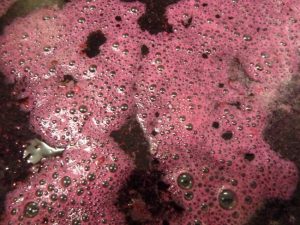For World Water Day on March 22, 2023, we wanted to shine a light on two things very important to us: keeping carbon in the soil and protecting our water.
As natural dyers, we have so many ways we can tackle these issues from collecting and reusing water creatively to simply stopping using hazardous pesticides as we grow our beautiful dye plants.
We hope our pointing you towards World Water Day 2023 can offer easy that ways you can be part. This World Water Day is about accelerating change to solve the water and sanitation crisis. And because water affects us all, we need everyone to take action. That means you!
And while we need to think globally, what would happen if you acted locally? What are some ways you could use your dyeing to make noise? We’re looking to see what you’ll do! Tag us on on social media and we’ll repost your good work.
Here are 10 ways we’ve come up with to natural dye and preserve as well as conserve water!
Look for creative ways to collect rainwater (think rain barrels and dehumidifiers): Do you remember when Jamie Bourgeois and Madeleine McGarrity were on FEEDBACK FRIDAY talking about madder and water quality? THAT was a game-changing presentation. Not only did we get to consider how water quality (pollution from Louisiana’s Cancer Alley) affected color, we got to see how water taken from a pond, a rain barrel or even a canoe sitting out in the rain changed the color. How can you use alternative water sources to tell a local environmental story?
Can’t help it, going to plug my own project using wastewater to grow dye plants. Plants love poop and pee. See image of madder roots in hydroponically-grown plants in wastewater.
Recharge your mordant baths: If you are mordanting with aluminum sulfate or aluminum acetate, your mordant bath may be reused between 2 and 7 (or some tell us more) times. For example, if we used 10 grams (2 teaspoons) of aluminum sulfate to mordant 100 grams of fabric, we would recharge the alum bath with 5 grams (1 teaspoon) for the second bath, and another teaspoon for the third bath. When the alum bath looks milky or cloudy, or has a lot of clumpy things floating in it, it’s time to draw a fresh mordant bath. Some of our diehard water conservers skim out the jellyfish and keep using the bath with great success.
You might also want to try out our newest cold water mordant, aluminum triformate.
Learn more about terms used on our Natural Dye Glossary
Don’t overfill your dye pots, and reuse your dye bath water: When drawing water for a dye bath, use the least amount of water possible so that the fibers can move in the dye bath. Many dye recipes recommend a fiber to water ratio of 1:20 or 1:30, which means 1 gram material to 20 grams water. This reduces both water and heating requirements. Plan on using your exhausted dye baths to dye additional fabrics, and if the dye bath is nearly clear, consider using the dye water for your next color. Of course, if you are painting, printing or bundle-dyeing, your water requirements are much lower than for immersion dyeing.
Dry fibers before washing: Let fibers get bone dry prior to rinsing and much of the dyestuff remains in the fiber instead of rinsing down the drain. With this trick, you rinse less and use less water. Be aware that protein fibers dipped in indigo vats should be rinsed fairly soon after their final dip as the alkaline indigo vat can damage protein fibers if not rinsed off. If you can’t wait for things to dry before rinsing you can also spin or squeeze out excess dye water from the goods, then proceed to rinsing. Again, you are getting rid of the water within the textile which allows you to rinse more efficiently.
Get creative! use your dye baths to make pigments, paints and pastels: On a recent FEEDBACK FRIDAY featuring artist and educator Natalie Stopka, Natalie focused on creative processes rooted in the natural world. Her pursuit of historical surface patterning techniques includes natural dyeing, lake pigment extraction, marbling, and printmaking. Her creativity alone will make you use up all those dye baths!
Compost to increase your dye garden’s soil health: The Kiss the Ground documentary says “Did you know that building healthy soils on a global scale is one of the best ways to draw down enough carbon to prevent a catastrophic climate crisis? ―And carbon storage isn’t soil’s only superpower; the ways that soil stands to positively impact the lives of billions worldwide are tangible and immediate: replenished water cycles, restored fertility, and regenerated ecosystems. What’s not to love?”
Stop using pesticides and herbicides on your natural dye plants: Environmental Health News says “Long thought to be relatively benign to non-target plants and animals, evidence is growing that glyphosate, the active ingredient of Roundup, may impact the metabolism, growth and reproduction of aquatic creatures and could be altering the essential gut bacteria of animals such as bees.”
Plant pollinator flowers: Native pollinator plants are highly efficient at absorbing carbon dioxide through photosynthesis and moving it deep into the roots to be released and trapped in the soil — so the bigger the root system, the more carbon dioxide trapped.
Goodwill silk shirt overdyed with cochineal bugs
Stop buying new textiles for dyeing and opt for used! Did you know that by reusing clothes and textiles through upcycling, you could save an estimated CO2 savings of 12kg per month (144kg per year or 316 lbs), just by extending the life of your clothing?” Neither did we.
Mardi Gras Dyer’s Coreopsis Seeds from Grand Prismatic
Plant food and dye plants together: Create shade for your soil with other plants and water less during dry months in your area. Consider cover cropping which is used to keep the soil protected with other plants. The main purpose is to increase soil fertility and soil quality; to manage soil erosion; improve water retention; manage weeds, pests, and diseases; and to increase biodiversity and native wildlife.
Want to learn more about our current climate crisis? Grab a copy of All We Can Save: Truth, Courage, and Solutions for the Climate Crisis.
In Fibershed, readers will learn how natural plant dyes and fibers such as wool, cotton, hemp, and flax can be grown and processed as part of a scalable, restorative agricultural system.













